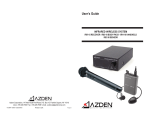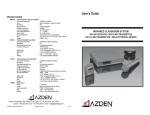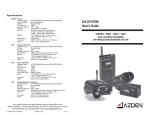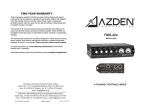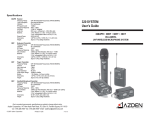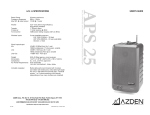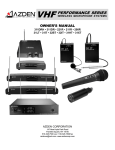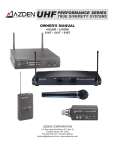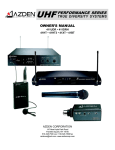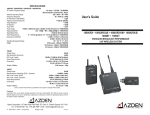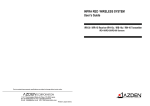Download Azden IRB-10 User`s guide
Transcript
User’s Guide INFRARED WIRELESS SYSTEM IRR-10 RECEIVER - IRB-10 BODY-PACK - IRH-10 HANDHELD IRD-10 SENSOR Azden Corporation, 147 New Hyde Park Road, Franklin Square, NY 11010 vox - 516.328.7500 • fax - 516.328.7506 • email - [email protected] © 2000 Azden Corporation Printed in USA P1014-01 C B G M N A F H D E E 3 P O 1 3 IRB-10 (Top View) 5 2 6 4 R Q S T U W V X Y i 7 TABLE OF CONTENTS EXPLODED VIEWS .................................................................................................................. i INTRODUCTION ...................................................................................................................... ii RECEIVER SETUP .................................................................................................................. 1 Receiver front panel ................................................................................................................. 1 Receiver rear panel .................................................................................................................. 1 Mounting the receiver ............................................................................................................... 1 Powering the receiver ............................................................................................................... 1 THE IRB-10 BODY-PACK ....................................................................................................... 1 Batteries for the IRB-10 ............................................................................................................ 1 Frequency selection ................................................................................................................. 2 Power mode selection .............................................................................................................. 2 Adjusting MIC gain ................................................................................................................... 2 Using the IRB-10 ...................................................................................................................... 2 Attaching and using the lanyard with the IRE-10 emitter .......................................................... 3 THE IRH-10 HANDHELD MIC ................................................................................................. 3 Batteries for the IRH-10 ............................................................................................................ 3 Frequency selection ................................................................................................................. 3 Using the IRH-10 ...................................................................................................................... 4 THE IRD-10 EXTERNAL SENSOR .......................................................................................... 4 Mounting bracket instruction .................................................................................................... 4 TROUBLESHOOTING ............................................................................................................. 5 SPECIFICATIONS ................................................................................................................... 6 TROUBLESHOOTING The single most important thing to ALWAYS check when trouble arises are the batteries. Make sure they are fresh and the POWER LED is glowing brightly. SYMPTOM No POWER LED CAUSE a. Receiver switch Is set to “OFF” - change to “ON” b. External 12VAC power source is not connected or is malfunctioning c. Dead or very weak battery in body-pack or handheld No audio from body-pack a. Make sure the volume on the receiver is turned up for the appropriate channel and the body-pack is powered ON b. If two body-packs are being used, make sure they are set to different frequency channels c. If using an external mic, make sure it is plugged in to the body-pack properly and the internal gain control has been adjusted. No audio from handheld mic a. Make sure the volume on the receiver is turned up for the appropriate channel and the handheld mic is powered ON b. If two handheld mics are being used, make sure they are set to different frequency channels Intermittent audio a. Make sure there is a clear path between the emitter and the receiving sensor. Best results are obtained when the receiving sensors are mounted high - above everyone’s head Limited working range a. Install extra external sensors b. If using a body-pack, set the Power Mode to Hi MICROPHONE SUGGESTIONS In addition to the IRE-10 emitter’s built-in uni-directional microphone, any one of many fine external microphones can be used. In the case of head or collar worn mics is that it would be possible to increase the gain (volume) without adding feedback noise. This is due to the proximity of the mic element to the speaker’s mouth. Any of the following Azden microphones will produce excellent results. • EX-503 Omni-directional Lavalier • EX-505U Uni-directional Lavalier • HS-12 Uni-directional Headset • HS-9 Omni-directional Headset • CM-20 Collar-worn iii 5 II. Frequency Selection: The IRB-10 can be set to transmit on either one of two preset frequencies. This is so that two different speakers can talk at the same time in the same room. While it does not matter which frequency is chosen for the body-pack, two transmitters cannot share the same frequency at the same time. To select the desired frequency (channel) slide the switch (T) as shown on the sticker on the back of the battery door. II. Power Mode Selection: The IRB-10 has two Power Modes - Lo and Hi. These modes can be selected via a switch (Q) inside the battery compartment, and affect two areas related to performance - battery life and area coverage. If the body-pack is switched to the Hi position (Q - to the right) the range is set to maximum (approximately 1600 square feet) while the battery life is reduced to approximately 10 hours with Alkaline batteries. If, on the other hand, the body-pack is switched to Lo the operating range is reduced to approximately 1200 square feet and the battery life increases to approximately 15 hours with Alkaline batteries. Experimentation is the only way to know which position is best for your room. We suggest, however, that it always best to use the Lo position if possible as that provides the most economical use. III. Adjusting MIC Gain: The MIC gain (volume) is adjustable to compensate for various microphone element characteristics. The adjustment (R) is located in the battery compartment and can be adjusted using the provided tool. While speaking into your microphone, adjust the gain (more gain-clockwise rotation, less gain-counterclockwise rotation) until the desired volume level is achieved. Best results are normally achieved when the gain control on the IRB-10 body-pack and the volume control on the IRR-20 receiver (D or F) are both at their mid-points. IV. Using the IRB-10: After inserting fresh batteries, the IRB-10 can be powered by sliding the ON/OFF Switch (N) to the ON position. The Power LED (O) will glow when the IRB-10 is powered ON as will the red LED on the front panel of the IRR-20 which corresponds to the chosen channel. Be sure to slide the Power Switch to OFF when not in use to preserve battery life. The Power LED on the mic will turn from green to red to indicate “Low Battery”. 2 The emitter (1) must be plugged into the IRB-10 (P) and either attached to the clothing with the clip (2) or worn around the neck with the lanyard (7) as described in section V. The emitter acts as the transmitter and, for best results, should be worn in such a way as to have a clear path to the receiving sensor(s). IV. Using the IRB-10 (continued): While there is a built-in microphone in the emitter, for best results an external microphone should be used. This microphone can be attached to the IRB-10 through the 3.5mm EXT. MIC jack (M). See page 5 for microphone suggestions. The internal microphone is disabled when an external mic is attached. The IRB-10 can be attached to the belt or other clothing by way of the metal belt clip. It is suggested that the body-pack be worn in the front portion of the body to avoid the possibility of damaging it. V. Attaching and Using the Lanyard with the IRE-10 Emitter: As described above, the emitter can be attached to clothing using the built-in clip (2). If that is not convenient, or if the built-in auxiliary mic is being used, it is best to use the included lanyard. To attach, insert the metal clip (2) through the holes (3) on the lanyard’s clear plastic slide (5). To adjust the emitter, hold the end of the lanyard (4) and slide the emitter up or down to the desired position. When using the built-in auxiliary mic it is best to slide the emitter up as far as possible so that it is close to the mouth (6). THE IRH-10 HANDHELD MIC (see illustration on page i) I. Batteries for the IRH-10: The IRH-10 uses two “AA” batteries or one AN-2A Ni-Cd for power. Batteries are placed in the battery compartment after unscrewing and removing the bottom portion of the mic handle (W). When using the AN-2A battery (U) carefully place a FULLY CHARGED battery in the compartment in the direction shown in the illustration (- to the top, + to the bottom). OBSERVE PROPER POLARITY! The IRH-10 can also use either 2 “AA” size Alkaline, Ni-Cd or Ni-MH batteries. When using this size battery, first place the two batteries (Y) into the included adapter sleeve (X) and then place in the compartment as shown. Again, OBSERVE PROPER POLARITY! Be sure to use FRESH “AA” Alkaline batteries, or, in the case of “AA” rechargeable batteries, be sure that they are FULLY CHARGED before use. Battery life depends on (1) the type of battery used, (2) the power mode chosen and other factors. II. Frequency Selection: The IRH-10 can be set to transmit on either one of two preset frequencies. This is so that two different speakers can talk at the same time in the same room. While it does not matter which frequency is chosen for the handheld mic, two transmitters cannot share the same frequency at the same time. To select the desired frequency (channel) slide the switch (V) as shown on the sticker on the side of the battery compartment. 3 THE IRH-10 HANDHELD MIC (continued ) RECEIVER SETUP (see illustration on page i) I. Using the IRH-10: After installing fresh batteries and choosing a frequency, simply turn the mic/transmitter on by sliding the ON/OFF switch up. The Power LED above the switch will glow as will the red LED on the front panel of the IRR-20 which corresponds to the chosen channel. Be sure to slide the Power Switch to OFF when not in use to preserve battery life. The Power LED on the mic will turn from green to red to indicate “Low Battery”. I. Receiver Front Panel: A. Power Switch - turns the receiver On and Off. B. Power LED - indicates the power state of the receiver. C. Receiving Sensor - internal receiving infrared sensor. D. Volume - adjusts the output volume Best performance is achieved when the mic is held close to the mouth and one speaks in a normal tone. The mic is designed to be held in the middle of the handle with the ON/OFF switch facing you. This allows the emitters at the base and near the mic element to operate at their peak. THE IRD-10 EXTERNAL SENSOR To increase the working range of the system, up to three external sensors can be added. IRD-10 sensors are powered by the receiver and can be plugged into the “EXT. SENSOR INPUTS” (H and I) on the rear panel. Plugging into inputs 1 and/or 2 (I) adds to the built-in front sensor (C) and extends the working range by 33 feet in any direction. Plugging into input 3 (H) automatically disconnects the front panel sensor. This way, if the front panel sensor is blocked (perhaps in a secured cabinet or closet) it can be replaced. Follow the illustrations below to install the IRD-10 mounting plate and sensor. Bend here II. Receiver Rear Panel: E. 2-External Sensor Inputs (RCA connector) - Plugging external sensors in here extends the receiver’s potential working distance. F. Output Jack - connects the receiver to a mixer or audio amplifier/speaker combination (1/4 inch connector). G. Power Input - plug in AC-AC adapter (BC-28i) to power receiver (12VAC-1.6A) H. Channel indicator and serial number. III. Mounting the Receiver: As infrared operates “line-of-sight” and can be interrupted by any solid object, it is strongly suggested that the receiver (or external sensors) be mounted or placed in a location that puts the receiving sensors above the audience’s heads or any other obstacles. IV. Powering the Receiver: The IRR-10 is powered by a BC-28i AC-AC power supply. Before turning the receiver ON be sure to plug it into an active 110-120VAC wall socket and into the rear of the IRR-10 (G). DO NOT USE any power supply except the BC-28i. THE IRB-10 BODY-PACK (see illustration on page i) Hold bracket in place and bend up to 90o 4 1st Mounting holes Slide IRD-10 on bracket Mount with 2 screws 2nd 3rd Bend up to desired angle 4th I. Batteries for the IRB-10: The IRB-10 uses two “AA” batteries for power. They are placed in the battery compartment (S). After sliding the battery compartment door off, carefully place FRESH batteries in the compartment in the directions shown on the sticker. OBSERVE PROPER POLARITY! The IRB-10 can use either Alkaline, Ni-Cd or Ni-MH batteries. In the case of rechargeable batteries, be sure that they are FULLY CHARGED before use. Battery life depends on (1) the type of battery used, (2) the power mode chosen and other factors. 1 SPECIFICATIONS System overall Working range.............................................IRB-10 – 1600 ft2 w/built-in sensor IRH-10 – 2500 ft2 w/built-in sensor Frequency response ...................................50Hz – 9kHz (±3dB) body pack (mic dependent) 50Hz – 5kHz (±3dB) auxiliary emitter mic 40Hz – 9kHz (±3dB) handheld Dynamic range............................................>100dB Operating temperature range .....................32o ~ 113oF (0o ~ 45oC) Noise reduction ...........................................2:1 log compander IRR-10 1-channel receiver Sub-carrier frequencies ..............................2.06MHz or 2.56MHz Type ............................................................super heterodyne – crystal controlled Modulation...................................................FM Signal-to-Noise ...........................................>90dB Image rejection ...........................................>40dB Reception sensitivity ...................................>25dBμV Reception selectivity ...................................±40kHz Audio output adjustment.............................line:+4dB max Audio output impedance.............................line:<1k ohms Power requirement......................................12VAC @ 1.6A Size .............................................................5.55" W x 5.1" D x 0.95" H (141 x 129.5 x 24mm) Weight .........................................................11oz (311g) IRB-10 – 2-channel body pack transmitter Sub-carrier frequencies ..............................2.06MHz & 2.56MHz switchable Modulation...................................................FM Audio distortion ...........................................< 1.0% (±40kHz deviation @ 1kHz) Mic input impedance...................................2.2k ohms Mic input jack ..............................................3.5mm Built-in auxiliary mic ....................................uni-directional electret Mic gain adjustment....................................Max to –50dB Battery type.................................................2-“AA” alkaline (2 x 1.5V) 2-“AA” rechargeable Ni-MH or Ni-Cd (2 x 1.2V) Battery life (100mA drain) ......................> 15 hours w/alkaline batteries – low power mode (160mA drain) ......................> 10 hours w/alkaline batteries – high power mode Size .............................................................3.94" H x 2.52" W x 1.06" D (100 x 64 x 27mm) Weight .........................................................4.65oz (132g) – transmitter (w/alkaline batteries) 1.34oz (38g) – clip-on emitter INTRODUCTION Thank you for selecting the Azden “RED” infrared system as your wireless solution. We are confident that it will perform beyond your expectations. For over 40 years Azden Corporation has been creating technologically advanced products. By taking advantage of the latest in CAD design and SMT production techniques, Azden’s engineers are able to produce products that exceed the published specifications and perform well beyond the warranty period. Azden “RED” represents a breakthrough in wireless. Instead of the normal radio waves that other wireless systems use, Azden “RED” uses invisible light beams in the infrared range. Through the use of infrared you will no longer be plagued by outside interference. “RED’s” enhanced performance assures you of the finest in audio clarity and reliability. The specially selected high-frequencies provide you with trouble free performance, even in fluorescently lit rooms. Like all infrared, Azden “RED” will not operate correctly outside in the sunlight. In the real world, the ability to use multiple systems in the same location without frequency interference will prove to be a tremendous benefit to you. Using infrared means that the audio generated in your room stays in your room. Your discussions cannot be overheard on other systems in other rooms. Designed by professionals - for professionals, Azden “RED” will provide you with years of worry-free, high-quality performance. IRH-10 – 2-channel handheld transmitter Sub-carrier frequencies ..............................2.06MHz & 2.56MHz switchable Modulation...................................................FM Audio distortion ...........................................< 1.0% (±15kHz deviation @ 1kHz) Microphone element type ...........................uni-directional dynamic Battery type.................................................2-“AA” alkaline (2 x 1.5V) 2-“AA” rechargeable Ni-MH or Ni-Cd (2 x 1.2V) 1- Azden AN-2A rechargeable Ni-Cd Battery life (260mA drain)...........................> 10 hours w/alkaline batteries Size .............................................................10.04" x 2.28" (255 x 58mm) Weight .........................................................9.1oz (258g) w/alkaline batteries) IRD-10 external sensor Cable length................................................32.8' (10m) Power ..........................................................powered by receiver Size .............................................................2" W x 3" W x 1" H (50.8 x 76.2 x 25.4mm) Weight .........................................................4oz (113.4g) Mounting included metal bracket 6 Due to constant improvements, specifiations are subject to change without notice. ii






